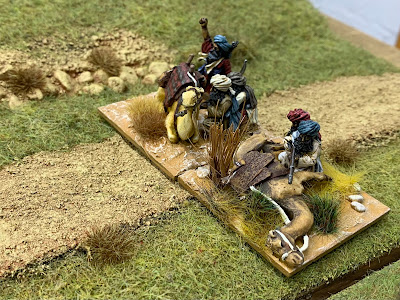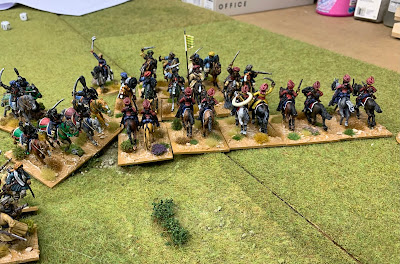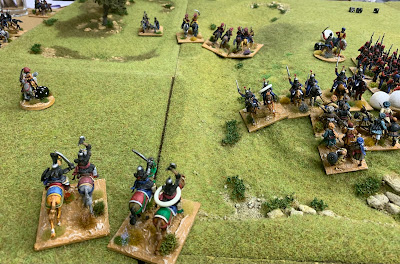With a pretty large Sikh Wars collection its been important to find rules we like that give us a flavour of the period. Sadly thats been tough.
So in the end I have decided to write my own, leaning heavily on the things I like from other sets.
Very early days but last night we had our first play test and despite some obvious gaps they worked ok. At least enough to stick with them and make some changes.
For our Game weak Brigade of Company infantry and another of cavalry would be supported by native allies.1st Brigade would be a unit of British Light Dragoons and a Unit of Governer Generals Body Guard with a Bengal Horse artillery 6 pounder.
2nd Brigade One unit of Bengal European Infantry and one of Bengal Native Infantry with a 9 pounder field gun,
3rd Brigade 2 regiments of matchlock armed native foot and 2 Zamburek Camel Guns
4th Brigade Two warbands of Pathan native foot
5th Brigade One warband Pathan light horse, one samall unit of armoured Pathan Nobles.
The Sikhs have similar numbers of troops.
The Sikhs have similar numbers of troops.
1st Brigade 1 Regiment of Sikh Currassier and 1 of Sikh Dragoons with a horse artillery gun
2nd Brigade 3 Battalions Sikh regulars with 1 Field gun
3rd Brigade 1 regiment of Matchlock armed foot and 2 warbands of Sikh natives with one very large gun
4th Brigade 2 units of armoured warband cavalry and 1 of unarmoured warband cavalry supported by 2 Zamburek camel guns.
Initiative is decided by cards randomly drawn for each command but we can just as easily roll for initiative. Each commander has a rating which allows him a number of orders and a number to beat in order to have his orders followed. I have kept it simple, Good 5, Average 4, Poor 3.
Initiative is decided by cards randomly drawn for each command but we can just as easily roll for initiative. Each commander has a rating which allows him a number of orders and a number to beat in order to have his orders followed. I have kept it simple, Good 5, Average 4, Poor 3.
Each troop type has a grade between 2 and 6. This is used both in melee and morale to help dictate outcomes.
I have split troop types into European, European Trained, Native Trained and Warband to give us a framework around which to build the strengths and weaknesses of the differing troop types available to commanders. There are suggested troop gradings within each of these but of course there will always be exceptions which are easily catered for.
Firing and melee is by by base. European troops have 3 actions where native troops have 2. This allows the Queens troops to be more manouverable and fire quicker as they did historically having the enhanced training and percussion muskets.
Warbands are tribal groupings or levies which operate in more of a mass than a formation, they have a bonus for movement and dont need to change formation as they "flow" around the battlefield.
Zambereks, a range in between muskets and light guns, they only get one firing dice per base regardless of range as they didnt use canister.
Tribal Warbands will be two bases deep to represent how they fought with the better armed and armoured more motivated warriors at the front, typically a 5 base unit will have 3 bases at the front and 2 behind, Only the front bases can fre and engage in the first round of melee.
British Light Dragoons, 3 actions and usualy level 5 troops.
These matchlock musketeers are trained but not to the same extent as those troops in British and Sikh pay that have been drilled by European Officers, as such they will be either lvel 2 or 3 troops.
OK so thats the premise, how did it play?
To start with everyone got moving straight at the enemy, as moving straight forward does not require an order there was very little stress on those parts of the rules as we closed.
I was pretty focused on monitoring the game and addressing rule questions so missed quite a few Photo opportunities, However first to close to combat where the Sikh regular Dragoons and a warband of Pathan tribal cavalry. Each side had the 3 bases in contact giving them 3 fighting dice, they gained an extra dice each as they were charging/counter charging the Dragoons had 3 dice for troop quality the Patahsn 2. So the Sikhs fought with 7 D6 and the Pathans with 6. Both sides needed a 6 to inflict a casualty. The Pathans won the first round of Melee but the Sikhs passed their morale taking the melee into a further round when the next card came out for the troops involved.
My Pathan infantry bowled up the hill and unleashed a short range volley at the Sikh regulars, the two units each having 3 bases at the front able to fire giving me 6 firing dice, As they are at effective range I need 5's to hit and score 2 hits, Chris needs a saving throw of 6 to save them but isnt able to. I have not removed a base in casualties so they have no need to test for morale..
Tribal Warbands will be two bases deep to represent how they fought with the better armed and armoured more motivated warriors at the front, typically a 5 base unit will have 3 bases at the front and 2 behind, Only the front bases can fre and engage in the first round of melee.
British Light Dragoons, 3 actions and usualy level 5 troops.
These matchlock musketeers are trained but not to the same extent as those troops in British and Sikh pay that have been drilled by European Officers, as such they will be either lvel 2 or 3 troops.
OK so thats the premise, how did it play?
To start with everyone got moving straight at the enemy, as moving straight forward does not require an order there was very little stress on those parts of the rules as we closed.
I was pretty focused on monitoring the game and addressing rule questions so missed quite a few Photo opportunities, However first to close to combat where the Sikh regular Dragoons and a warband of Pathan tribal cavalry. Each side had the 3 bases in contact giving them 3 fighting dice, they gained an extra dice each as they were charging/counter charging the Dragoons had 3 dice for troop quality the Patahsn 2. So the Sikhs fought with 7 D6 and the Pathans with 6. Both sides needed a 6 to inflict a casualty. The Pathans won the first round of Melee but the Sikhs passed their morale taking the melee into a further round when the next card came out for the troops involved.
My Pathan infantry bowled up the hill and unleashed a short range volley at the Sikh regulars, the two units each having 3 bases at the front able to fire giving me 6 firing dice, As they are at effective range I need 5's to hit and score 2 hits, Chris needs a saving throw of 6 to save them but isnt able to. I have not removed a base in casualties so they have no need to test for morale..
In Chris's turn his return volley also has 5 dice needing 5's, he fails to roll any.
Next turn and my small unit of Armoured Pathan Warband charge into the melee with the Sikh Dragoons. as the second round of melee all troops from the units involved may fight. I have the advantage in numbers now but Chris;'s quality counts and he inflicts three casualties to my 2.
Next turn and my small unit of Armoured Pathan Warband charge into the melee with the Sikh Dragoons. as the second round of melee all troops from the units involved may fight. I have the advantage in numbers now but Chris;'s quality counts and he inflicts three casualties to my 2.
My Pathans are class 2 they need to roll a 5 or 6 on either of two dice to stand, they fail and retire dis-ordered a full move. My Pathan Noble Cavalry are class 3 so get 3 dice and pass. The Noble Cavalry do get a saving throw in Melee due to their armour, needing a 6 on a D6, they achieve this . Next round it will be 3 bases of Pathan Nobles against the remaining 4 of Sikh Dragoons.
Chris's Currassier advance in support of the Dragoons, but I wonder if he might just sweep them into the Pathan foot.
Theres always one! Chris manages to save his Cavalry with a host of 6's. Melee I dont normally allow a saving throw, except for armoured cavalry and troops defending an obstacle. Clearly this armour is pretty damned good on the Sikh Cavalry.
The big gun fires a long range shot at the Sepoys but misses, this will be soemthing of a theme.
Chris's warbands get going, I have given warbands and skirmishers an extra action of movement to allow them some flexibility not afforded regulars trying to stay in formation. Their downside being only the front ranks are immediatly involved in any fighting. I see these like any other tribal society where the best armed and most enthusiastic warriors lead from the front with a tail of less enthusiastic followers behind.
Chris Warband cavalry are also closing with the company horse on our right. Very colourful these chaps. Again extra movement action to allow for their lack of formation and the better troops to the fore.
Steve advances the Light Dragoons steadily waiting his moment to pounce.
Steves Zambureks unlimber next to the village and open up on the Sikh artillery inflicting one casualty. A nuisance these camel guns.
Steve charges the Sikh light cavalry who use their ability to fire a hasty shot and evade, needless to say with Matchlocks from horseback they miss entirely, we make some amends to the evade here to avoid the Sikhs being automatically caught. Chris then throws in his armoured Sikhs who give a good account of themselves
Chris's Currassier advance in support of the Dragoons, but I wonder if he might just sweep them into the Pathan foot.
Theres always one! Chris manages to save his Cavalry with a host of 6's. Melee I dont normally allow a saving throw, except for armoured cavalry and troops defending an obstacle. Clearly this armour is pretty damned good on the Sikh Cavalry.
The big gun fires a long range shot at the Sepoys but misses, this will be soemthing of a theme.
Chris's warbands get going, I have given warbands and skirmishers an extra action of movement to allow them some flexibility not afforded regulars trying to stay in formation. Their downside being only the front ranks are immediatly involved in any fighting. I see these like any other tribal society where the best armed and most enthusiastic warriors lead from the front with a tail of less enthusiastic followers behind.
Chris Warband cavalry are also closing with the company horse on our right. Very colourful these chaps. Again extra movement action to allow for their lack of formation and the better troops to the fore.
Steve advances the Light Dragoons steadily waiting his moment to pounce.
Steves Zambureks unlimber next to the village and open up on the Sikh artillery inflicting one casualty. A nuisance these camel guns.
Steve charges the Sikh light cavalry who use their ability to fire a hasty shot and evade, needless to say with Matchlocks from horseback they miss entirely, we make some amends to the evade here to avoid the Sikhs being automatically caught. Chris then throws in his armoured Sikhs who give a good account of themselves
The Light Dragoons win but take 25% casualties and have to spend a turn dis-ordered in order to reform. The commander will need to have an order passed but as he his level 4 that should be easy enough.
In the right centre of the Sikh line the Sikh regulars charge the Pathan Warbands. The Pathans are narrowly beaten but hold their morale and go into another round of melee next time. The Sikhs had the dice bons for bayonets but as they didnt use them I probably need to remove that and replace it with aggressive or similar.
In the right centre of the Sikh line the Sikh regulars charge the Pathan Warbands. The Pathans are narrowly beaten but hold their morale and go into another round of melee next time. The Sikhs had the dice bons for bayonets but as they didnt use them I probably need to remove that and replace it with aggressive or similar.
The Sikh Curassier charge the end of my Pathan Warband connecting with 2 bases. but the Pathan hold them off. inflicting heavy casualties. We decide at this point that once a unit passes its charge test any foot charged by horses that is not in square must test for beign charged to see if they stand.
The Cavalry melee on the British right intensifies, one warband of armoured cavalry retreats after losign a base of troops but the other holds and inflicts a base of casualties ont eh Light Dragoons.
In the centre the Sikh irregular warbands charge the village and the Sepoys, the unit facing the Sepoys is driven off with heavy loss but the one charging the natives matchlocks in the villages closes to contact, They are held by the Matchlock men but not driven off.
The Cavalry melee on the British right intensifies, one warband of armoured cavalry retreats after losign a base of troops but the other holds and inflicts a base of casualties ont eh Light Dragoons.
In the centre the Sikh irregular warbands charge the village and the Sepoys, the unit facing the Sepoys is driven off with heavy loss but the one charging the natives matchlocks in the villages closes to contact, They are held by the Matchlock men but not driven off.
At this point we run out of time and raw the game to a close. Another half an hour or so might see us come to a conclusion. The British irregulars did well as might be expected. The Pathan irregulars maybe a little better than might have been hoped for. Overall not bad though.
The huge melee on the British and allied left would eventually swing for the Sikhs no doubt but had provided some good entertainment.
The Sikh dragoons were eventually destroyed by the remaining Pathan Noble cavalry, although they were in turn down to 50% strength.
Quite a few things to amend but the basic premise stood the first test and it is worth pursuing. Working through the changes and hopefully another run through very soon.
The huge melee on the British and allied left would eventually swing for the Sikhs no doubt but had provided some good entertainment.
The Sikh dragoons were eventually destroyed by the remaining Pathan Noble cavalry, although they were in turn down to 50% strength.
Quite a few things to amend but the basic premise stood the first test and it is worth pursuing. Working through the changes and hopefully another run through very soon.
Thanks for stopping by.































A very interesting read, good to see how your rules are shaping up and it's great to see your lovely Sikh Wars collection, so many great miniatures on show.
ReplyDeleteCheers Donnie, hope to have a couple more battle reviews and rule amends to share soon.
DeleteLooks and sounds great Roger.
ReplyDeleteThanks a lot Ray
DeleteFantastic looking game Roger....I have a good few Old Glory Sikh Wars Brits myself, intended for a stalled 1840 in Afghanistan collection.....hmmmm.....!
ReplyDeleteDo it! The Afghans are useful too, a great many of the irregulars in the Punjab were Pathan
DeleteIt’s a great collection and I’m enjoying getting to the point where you’re playing with it the way you want to. Cheers, Chris
ReplyDeleteCheers Chris for the support
DeleteSome good ideas there Roger. Worth developing I reckon. Colin
ReplyDeleteThanks Colin, some extra ideas to introduce next time.
DeleteLovely looking battle 👍
ReplyDeleteCheers Matt
DeleteDid British use irregular infantry or cavalry. Not in the OOBs I’ve seen. Sikhs definitely used irregular troops in most battles.
ReplyDeleteThey certainly did, check out the OOB's for the battles around the Siege of Multan, lots of Pathans fighting with the British.
DeleteI think so long as the rules would work for Napoleonic then you have a start point
ReplyDeleteThanks Scott, the irregular nature of many of the troops and the difference between native trained and European trained troops was significant, I am not sure the paraelels are the same for most Napoleonic armies.
DeleteLovely collection- Sikh armies are so colourful! Don't let the lack of commercial rulesets - or lack of suitability- worry you. Writing your own can be very rewarding ( if frustrating at times). The bulk of my group's games are with home grown sets. we borrow heavily from rules we like- the 'must-haves' for the rules whether it's the combat or the morale or movement . It may take a while but it is worth it in the end!
ReplyDeleteCheers John, I have to agree, already taking shape, couple more AARs to come.
ReplyDeleteZamburaks, depending when, where and who might indeed use 'canister' of a sort by loading up with multiple projectiles - shotgun style. Perhaps when extending an infantry line to augment shooting.
ReplyDeleteHowever, making them reasonably, weak, individually is probably right.
Your figs look superb.
Much appreciated David. I think the balance is right for the Zamburaks, be interesting to play with a lot of them in a game.
Delete